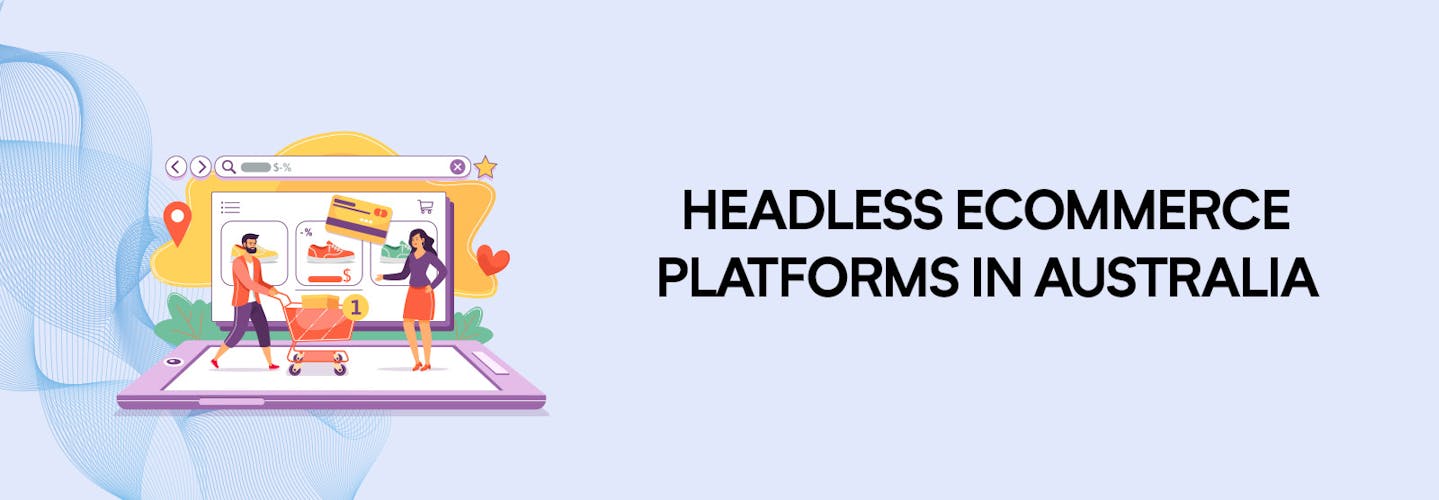
Best Headless eCommerce Platforms in Australia 2025-26
Have you heard about the latest buzzword in the ecommerce world down under? It’s called “headless commerce.
Sounds a bit strange, doesn’t it? But don’t worry, it’s not as gruesome as it sounds.
In fact, it’s a revolutionary approach that’s transforming the way businesses operate online, especially here in Australia.
But what exactly is headless commerce? Why is it becoming so popular in Australia? And how can it benefit your business?
Let’s dive into the world of headless commerce and discover why it’s making waves in the Australian ecommerce landscape. Ready to join the ride?
Definition of Headless Commerce Platforms

So what exactly is headless commerce? Simply put, it is a modern approach to ecommerce that decouples the front-end and back-end systems.
This means that the presentation layer (front-end) is separated from the business logic layer (back-end). In other words, instead of using an all-in-one platform where everything is tied together, businesses can choose separate solutions for each layer and connect them through APIs.
Importance of headless commerce in the Australian market
According to Statista, revenue in the eCommerce market in Australia is projected to reach US$43.21bn in 2023 and is expected to show an annual growth rate (CAGR 2023-2027) of 10.40%, resulting in a projected market volume of US$64.18bn by 2027.
Headless commerce platforms offer many benefits that traditional platforms cannot match.
They provide greater flexibility in terms of customization and personalization options, as well as improved user experiences across multiple touchpoints including mobile devices and social media channels.
In the next sections of this article, we will dive deeper into the benefits and challenges of using a headless commerce platform in Australia, as well as explore some of the top solutions available in the market.
What are the benefits of using a headless commerce platform?
1. Flexibility and Scalability
When it comes to managing an online store, flexibility and scalability are key. Headless commerce platforms provide businesses with the ability to quickly adapt to changing market conditions, such as new products or services.
This is because headless platforms separate the front-end presentation layer from the back-end commerce platform.
As a result, businesses can easily add new features or functionality without affecting the overall performance of their website.
Scalability is also important for growing businesses. With a headless commerce platform, businesses can easily scale their online store as they grow without having to worry about any limitations in terms of capacity or functionality.
2. Customization and Personalization
One of the biggest advantages of using a headless commerce platform is that it enables businesses to create highly customized experiences for their customers.
Since every aspect of the front-end presentation layer is completely customizable, businesses can create unique experiences that align with their brand identity.
Personalization is another key benefit that headless commerce solutions offer.
By leveraging customer data and insights, businesses can create personalized shopping experiences that cater to each individual shopper’s needs and preferences.
3. Improved User Experience
The user experience is everything in eCommerce. Without a positive user experience, shoppers will quickly leave your website in search of a better alternative.
Fortunately, headless commerce platforms provide several benefits that directly impact the user experience.
For one, by decoupling the front-end presentation layer from the back-end commerce platform, pages load faster and more smoothly than traditional eCommerce solutions - this ultimately makes for better user experience.
Additionally, since customization and personalization are much easier with a headless platform than with traditional eCommerce solutions such as Aasaan, Magento Commerce Cloud or Shopify Plus - customers get what they want faster which leads them down an enjoyable path on the website.
Headless commerce platforms also give businesses the ability to leverage cutting-edge technologies like artificial intelligence and machine learning, which can provide personalized recommendations, improve search results, and more. All of these factors contribute to a better overall user experience.
4. Accessibility
It allow businesses to be more accessible on a wider variety of devices.
Since the front-end presentation layer can be completely customized, businesses can create unique experiences that are optimized for both desktop and mobile devices. This increased accessibility ultimately leads to more sales and higher customer satisfaction.
Ultimately, headless commerce platforms offer several benefits that make them an attractive option for businesses looking to improve their eCommerce operations.
From flexibility and scalability to customization and personalization, these platforms provide numerous advantages over traditional eCommerce solutions.
Top Headless Commerce Platforms in Australia
Australia is a growing market for headless commerce platforms, and there are several options available for businesses of all sizes. Here are the top 8 headless commerce solutions in Australia:
1. Aasaan
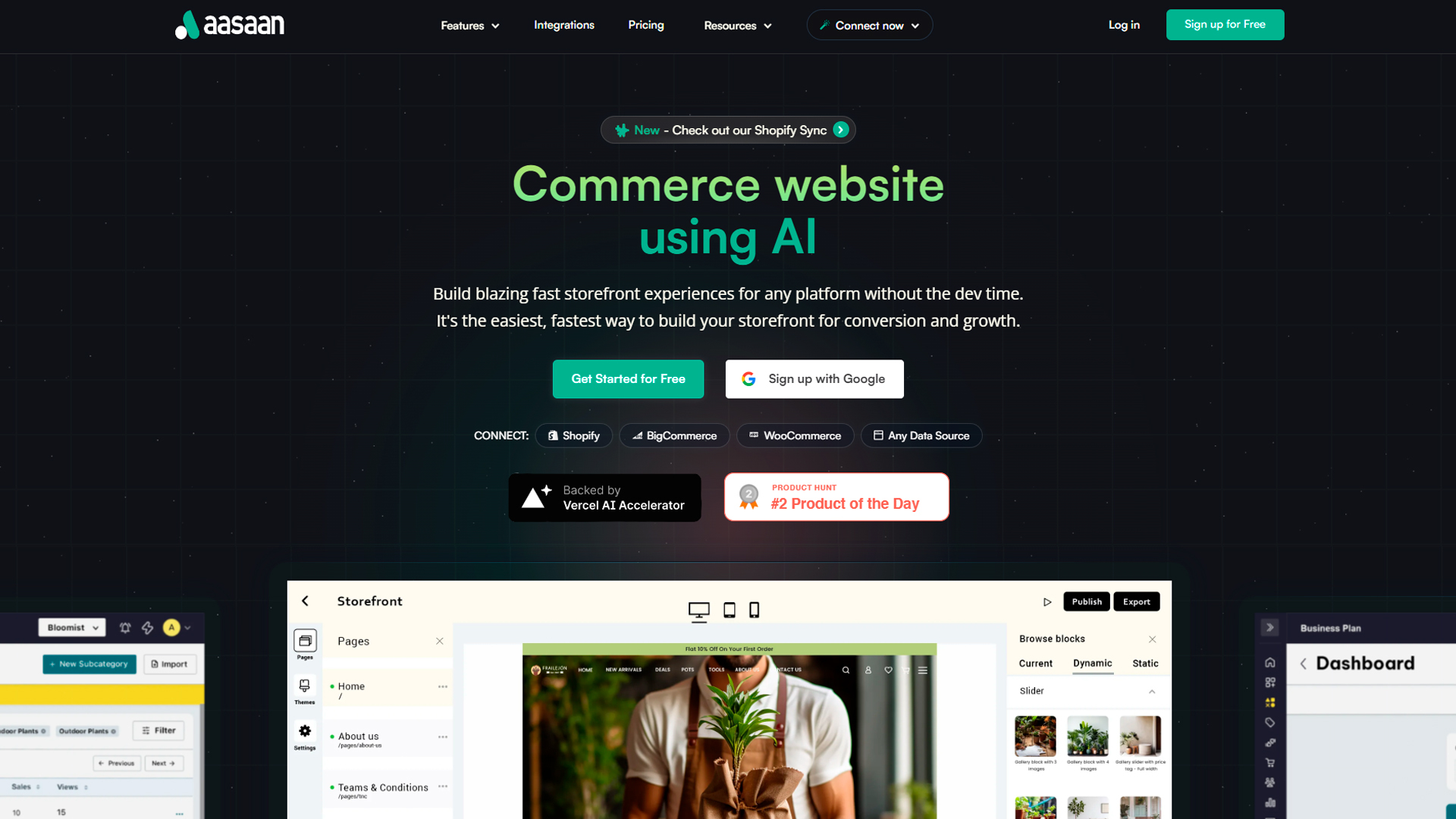
Aasaan is a no-code SaaS platform designed for small and medium-sized enterprises (SMEs) to build storefronts and mobile apps.
It leverages a template-driven front-end that allows users to set up their online presence in just a few minutes.
The platform is designed to help businesses grow their ecommerce operations in their own way, providing a headless store builder and an API-first commerce platform for visually building next-generation shopping experiences.
Features
- Lightning-Fast Site Speed: Aasaan promises a 70% increase in site speed, ensuring a seamless shopping experience for your customers.
- Boost Your Conversion Rates: With Aasaan, businesses can witness a remarkable 38% uplift in conversion rates, maximizing their sales potential.
- Elevated Average Order Value: Aasaan helps businesses enjoy a 20% surge in average order value, driving higher revenue per transaction.
- Accelerated Time to Market: Aasaan provides a 10x faster time to market, enabling businesses to stay ahead of the competition.
- Seamless Integrations: Aasaan seamlessly integrates with your existing backend or you can start with their API-first commerce platform and harness the power of best-in-class technology within seconds.
- Manage your Business: With Aasaan, you can manage all aspects of your business from a single admin app. This includes managing orders, fulfillments, customers, inventory, payments, and more.
Pricing
- Standard plan: For anyone to get started quickly. It costs $18 per month if billed annually or $25 per month if billed monthly.
- Premium plan: For merchants and startups to help grow business with branding. It costs $50 per month if billed annually or $65 per month if billed monthly.
- Business plan: Enables advanced merchants with advanced features. It costs $165 per month if billed annually or $200 per month if billed monthly.
- Enterprise plan: Unlimited scalability, greater control, and dedicated resources for D2C brands to scale. It requires you to contact sales for a custom quote.
2. Shopify Plus
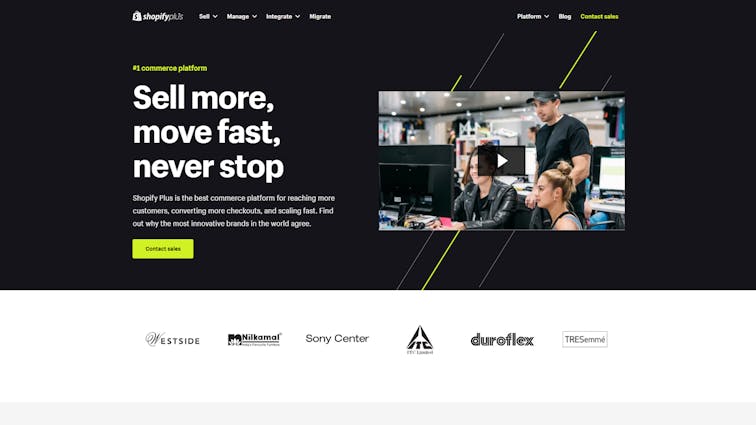
Shopify Plus is a top-tier commerce platform designed for businesses that are scaling fast and want to keep up with the pace of their growth.
It’s an all-in-one solution that allows businesses to sell across multiple channels and markets from a single platform. This means centralized data and powerful customer insights across every part of your business.
Features
- All-in-one commerce platform: Shopify Plus allows you to sell anywhere you want from one platform. This includes direct-to-consumer, retail, B2B, and social media channels.
- Designed for conversion: Shopify Plus is designed to convert up to 91% more from day one. It offers data-targeted audiences across popular social marketplaces, the best-converting checkout on the internet with Shop Pay, and customer retention with loyalty programs and personalized touchpoints.
- Made for scale: Shopify Plus is built to support your brand’s growth. It offers a share of the total U.S. ecommerce market, the ability to sell in multiple countries and languages, and has facilitated billions in total sales from millions of Shopify businesses.
- Built for speed: With Shopify Plus, you can be first to market with new features as they drop, and respond to shifting consumer trends in real time. It offers a customizable, easy-to-use platform for fast migration and launch of your online store.
- Optimized for performance: Shopify Plus offers 99.98% average uptime, the ability to handle over 10,000 checkouts per minute with unlimited bandwidth and transactions, built-in security, compliance, data encryption, and fraud and bot protection.
- Committed to support: Shopify Plus offers 24/7 priority technical support by phone, email, or live chat, platform knowledge and industry insights through the merchant success program, and personalized migration, launch, and account management support at no extra cost.
Pricing
Shopify Plus does not provide specific pricing information on their website. They recommend contacting their sales team for a personalized quote based on your business needs.
3. BigCommerce
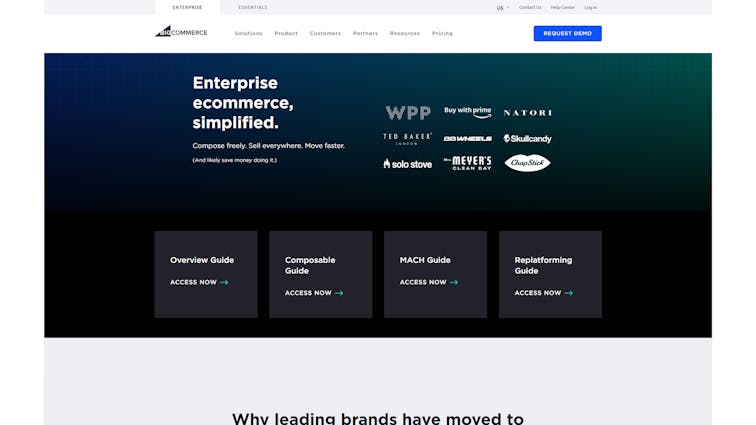
BigCommerce is a powerful and flexible headless commerce platform that enables businesses to create differentiated, scalable, and feature-rich experiences for their customers.
It is designed for businesses of all sizes and offers a wide range of customization options.
Features
- Open SaaS platform: BigCommerce leverages the benefits of an open platform with the ease and convenience of a software-as-a-service solution, giving you the best of both worlds.
- Headless commerce support: The platform provides out-of-the-box tools and APIs, allowing you to build custom front-end experiences that can integrate with the rest of your tech stack.
- Multi-channel selling: BigCommerce allows you to sell through various channels, such as web, mobile , social media, marketplaces, and brick-and-mortar locations, giving you a unified commerce experience.
- Customization and integration: With a vast library of apps and integrations, BigCommerce makes it easy for you to connect, customize, and extend the platform to fit your unique business requirements.
- Security and compliance: BigCommerce prioritizes the security of your data with features like 99.99% uptime, ISO/IEC 27001:2013 and PCI DSS Level 1 certified hosting, protection against DDoS attacks, and secure customer data handling.
- Expert support and resources: Benefit from 24/7 technical support as well as a wealth of resources like a Knowledge Center, developer community, and expert-provided education materials to guide you through every phase of your business growth.
Pricing
BigCommerce offers four pricing plans to suit businesses of all sizes:
- Standard: $29.95 per month
- Plus: $79.95 per month
- Pro : $299.95 per month
- Enterprise: Custom pricing available upon request.
4. Spree Commerce
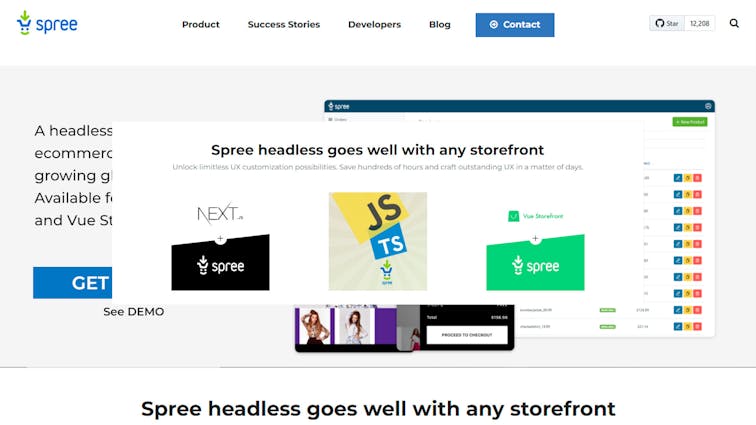
Spree Commerce is an open-source headless eCommerce solution that caters to businesses of all sizes.
It offers a high level of customization, flexibility, and performance for businesses looking to build unique and modern online stores.
Features
- Flexible and modular platform: Spree Commerce allows you to pick and choose the components that best fit your business requirements, providing flexibility and making the platform highly adaptable.
- Headless and API-driven: The platform offers a decoupled architecture and strong APIs, facilitating seamless front-end customization and integration with the rest of your tech stack.
- Versatile extensions: Browse and use Spree’s wide selection of extensions that offer powerful functionalities and increase the ease of customizing your eCommerce experience.
- Multi-language and currency support: Spree Commerce enables you to expand your market reach with built-in support for multiple languages and currencies, allowing you to cater to a global audience.
- Performance and scalability: Designed for smooth performance and growth, Spree Commerce ensures your storefront can handle traffic surges and support your business as it expands over time.
- Community and support: Leverage the expertise and knowledge of the Spree Commerce community and available technical support resources to help your business thrive.
Pricing
Spree Commerce, being an open-source platform, is available free of charge. However, costs associated with hosting, third-party integrations, extensions, and customizations may apply.
5. WooCommerce

WooCommerce is an open-source eCommerce platform built specifically for WordPress websites.
It is highly customizable and user-friendly, making it a popular choice for businesses looking to set up an online store.
Features
- Built for WordPress: As a plugin, WooCommerce seamlessly integrates with WordPress websites, allowing you to manage your online store from the familiar WordPress dashboard.
- Highly extensible: With thousands of free and paid extensions available, you can easily customize and enhance the functionality of your WooCommerce store to meet your specific business needs.
- Multichannel support: WooCommerce allows you to sell products through various sales channels, including physical retail locations, social media, marketplaces, and more.
- Flexible checkout options: Customize your checkout experience to match your brand and business requirements with options such as guest checkout, one-click checkouts, and more.
- Multiple payment gateway integrations: WooCommerce supports a wide range of payment gateways, including popular options like PayPal, Stripe, and Amazon Pay.
- Product variations and bundling: Create and manage complex product offerings by creating variations, product bundles, and more to meet your customers’ needs.
- Robust community and support: Benefit from a large community of WooCommerce users, extensive documentation, and comprehensive support resources to help you scale your online store.
Pricing
WooCommerce itself is free to use, but costs associated with hosting, themes, plugins, extensions, and customizations may apply.
6. Elastic Path
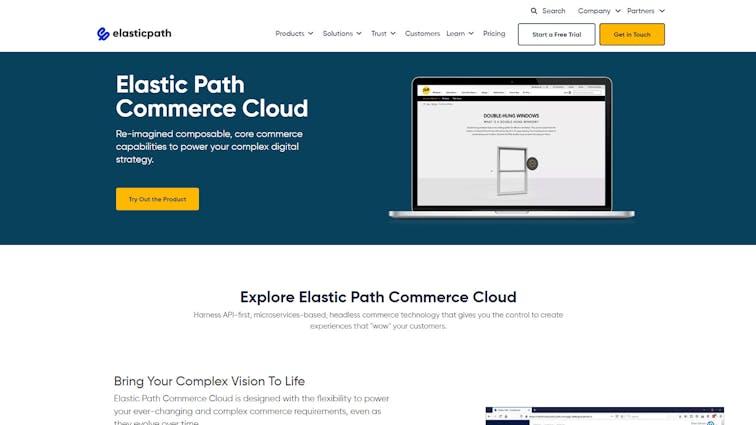
Elastic Path is a flexible, API-driven headless commerce platform designed for businesses looking for a solution that can easily adapt to their unique needs and desired customer experiences. It enables rapid innovation and customization, making it a go-to choice for businesses that prioritize agility and scalability.
Features
- Headless and API-first architecture: Elastic Path’s decoupled architecture allows you to build custom front-end experiences and integrate effortlessly with other systems, enabling rapid innovation and adaptation to changing market demands.
- Composable Commerce: Easily create unique, customizable shopping experiences by assembling various components and microservices from Elastic Path and third-party solutions.
- Flexible Data Model: Adapt and extend Elastic Path’s data model to cater to unique business requirements, supporting both simple and complex customizations.
- Omnichannel Experiences: Offer seamless shopping experiences across various digital touchpoints and channels, such as web, mobile, AR/ VR, IoT, and voice-enabled devices.
- Robust APIs: Build powerful commerce experiences from scratch or connect existing systems using a comprehensive library of APIs that facilitate customization and integration.
- Performance and scalability: Designed for high-performance and growth, Elastic Path allows your online store to support increasingly large volumes of traffic and expand as your business grows over time.
- Dedicated support and consultative services: Utilize Elastic Path’s dedicated support, consulting services, and the knowledge of its expert community to ensure your online store’s success and ongoing development.
Pricing
Elastic Path offers customized pricing based on your business requirements and needs. To receive an accurate quote, you can contact their sales team.
7. PrestaShop
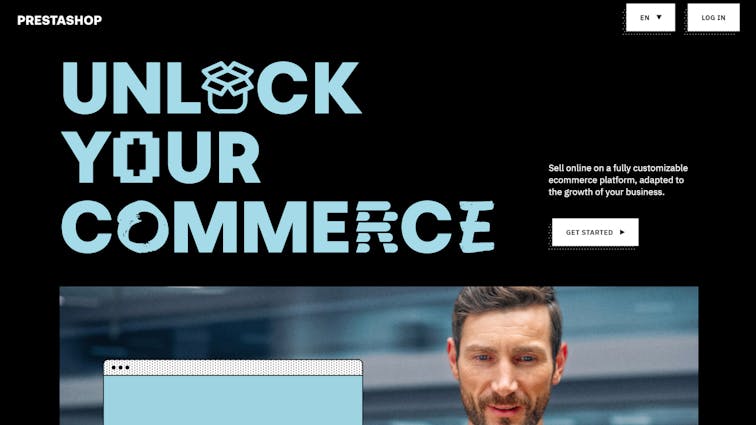
PrestaShop is an open-source eCommerce platform that offers a great balance between functionality, flexibility, and ease of use, making it a popular choice among businesses of various sizes. With over 300,000 merchants using the platform, PrestaShop provides a proven solution for establishing and growing an online store.
Features
- Customizable design: Utilize PrestaShop’s built-in templates and themes or customize the look and feel of your store to showcase your brand identity and create a strong customer experience.
- Extensive module marketplace: Access a wide range of both free and paid modules that offer powerful features and functionalities, simplifying the customization and development of your eCommerce store.
- Internationalization support: Cater to customers around the world using built-in features, such as multi-currency, multi-language, and localized payment options to ensure successful market penetration.
- SEO friendly: Optimize your store’s search engine visibility with PrestaShop’s SEO capabilities, generating more organic traffic and increasing conversions.
- Product and inventory management: Easily manage product listings, attribute combinations, and stock levels using PrestaShop’s intuitive back-end interface.
- Multiple payment options: Choose from a wide selection of integrated payment gateways, or integrate your preferred payment solution to offer customers multiple checkout options.
- Cross-selling and upselling: Leverage PrestaShop’s marketing features, such as related product suggestions and promotions, to boost revenue and encourage repeat purchases.
- Robust community and support: Tap into a vast community of knowledgeable PrestaShop users, developers, and support resources to help optimize and scale your online store.
Pricing
While PrestaShop is free to download and use, costs related to hosting, premium themes, modules, and custom development may apply. Additionally, some payment gateway integrations may charge transaction fees.
8. Snipcart
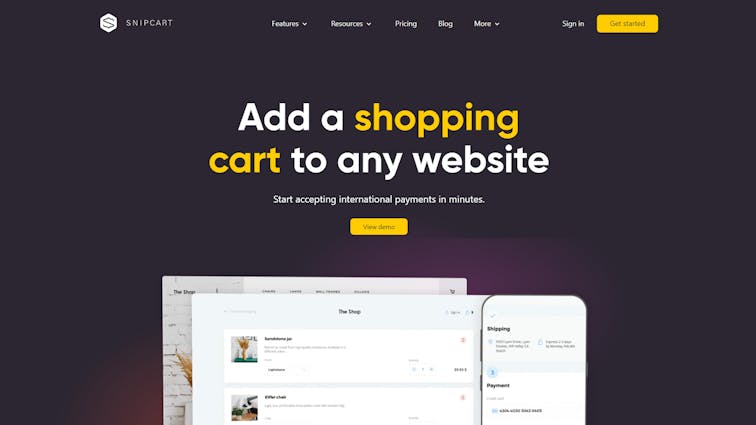
Snipcart is an ecommerce solution that allows you to add a shopping cart to any website in minutes.
It’s designed to be easy to integrate, saving time and money for businesses. Snipcart is a developer-centric platform, offering a high degree of customization and control over the shopping experience.
It’s trusted by thousands of developers and merchants worldwide.
Features
- Products: Snipcart allows you to sell physical products all over the world. It provides features for managing shipping, inventory, and discounts.
- Developer-Friendly: Snipcart is designed to work with your favorite website technology, whether it’s Jamstack, coupled, or something else. It offers APIs and webhooks for seamless integration with external tools.
- Merchant-Friendly: Snipcart provides features to boost sales, such as discounts, abandoned cart retrievals, and customized shipping methods. It also provides sales analytics to measure what works and what doesn’t.
- Customer-Friendly: Snipcart provides a secure and fast checkout experience. It’s designed to be simple and focused, getting customers to the “pay now” button quickly.
- Seamless Integrations: Snipcart can be integrated with your favorite tools to enhance your customers’ shopping experience and boost your business growth.
Pricing
Snipcart charges 2% per transaction, in addition to payment gateway fees. Your revenues get directly deposited into your account, and Snipcart charges a small percentage based on the sales you made.
How to Choose the Right Headless Commerce Platform for Your Business?
1. Consider Your Business Needs and Goals
Choosing a headless commerce platform that fits your business needs and goals is crucial. Look for a platform that can support your current operations and future plans.
Consider factors such as scalability, customization options, and integration with other systems.
For example, if you plan to expand your business in the future, you’ll need a platform that can handle increased traffic volumes without sacrificing performance.
In addition to technical requirements, consider the specific needs of your customers. If you’re targeting younger audiences who are likely to shop on mobile devices, make sure you choose a platform with strong mobile capabilities.
2. Evaluate the Features and Capabilities of Each Platform
When evaluating headless commerce platforms, it’s essential to assess their features and capabilities thoroughly.
You should look at their e-commerce functionalities such as inventory management, shipping options, payment gateways available, SEO tools available among others. Make sure that they have all the features that align with your business objectives.
You will also want to assess the API integrations available for each platform since Headless requires seamless integration with other systems like CMS or PIMs .
This is important because it will be easier for developers to work on integrating custom modules or applications from third-party vendors.
3. Look at Pricing Models and Support Options
Pricing models are another important factor when choosing a headless commerce platform. There are many different pricing models out there like SaaS (Software as a Service), PaaS (Platform as a Service) or even self-hosting approaches if you have the technical expertise in house.
In addition to pricing models - customer support is paramount especially when something goes wrong which inevitably happens during implementations or customizations - For example - Is support available 24/7?
What channels can I use to contact the support team? You want to make sure that you’re able to get help when you need it.
4. Consider the Platform’s Security Measures
Security is a critical aspect of any e-commerce platform, and headless commerce solutions are no exception. Every platform comes with different security protocols, so it’s essential to evaluate them before making a decision.
Look for features like two-factor authentication (2FA), SSL certificates, PCI-DSS compliance among others. These features can help protect sensitive customer data and prevent cyber attacks.
5. Assess the Training and Onboarding Process
It’s important to consider how easy it is to learn and use a headless commerce platform. If your team needs extensive training just to operate the software, it could hurt productivity in the long run.
Look for platforms that offer comprehensive onboarding materials and support resources so that your team can get up-to-speed quickly.
Choosing a headless commerce platform requires careful consideration of various factors such as scalability, customizations options integration capabilities among others.
By taking these factors into account - businesses will be better positioned to select the right headless commerce platform for their specific requirements while also ensuring customer satisfaction on an ongoing basis.
Case studies: Successful businesses using headless commerce solutions in Australia
1. Showpo:

Showpo, an Australian-based online women’s fashion retailer, has been able to stay ahead of the game by using a headless commerce platform.
Being a company that values innovation and experimentation, Showpo has been able to leverage the benefits of headless commerce to give their customers an exceptional shopping experience.
By using a content management system (CMS) with headless commerce capabilities, Showpo is able to display engaging content on their website that is tailored for each customer.
This level of personalization has helped them increase their sales and foster customer loyalty. Additionally, Showpo’s headless approach makes it easy for them to add new features and integrations as they expand into other markets.
2. Kogan.com: Scaling up with Headless Commerce

Kogan.com started as a small startup company and has now grown into one of Australia’s largest online retailers.
The company attributes its success, in part, to its use of a headless commerce platform. By leveraging the flexibility and scalability of this platform, Kogan.com is able to manage high traffic volumes without sacrificing performance or user experience.
One of the key benefits for Kogan.com is the ability to customize their storefronts for different regions or markets without disrupting their backend systems.
Their content management system also allows them to easily create new landing pages or promotional campaigns which ultimately helps drive sales.
3. Booktopia: Streamlining Business Operations with Headless Commerce

Booktopia is Australia’s leading online bookstore and prides itself on being at the forefront of ecommerce innovation in their industry sector.
In order to stay ahead of competition and meet customer demands Booktopia switched over from traditional ecommerce solutions so that they could better manage growing product lines more efficiently through having granular control over their ecommerce experience.
The headless commerce solution enabled Booktopia to streamline their fulfillment systems and processes which ultimately led to the company being able to offer faster and more reliable shipping times.
Additionally, by using a headless content management system they are able to deliver a personalized shopping experience that is tailored for each customer’s interests.
Challenges of Implementing a Headless Commerce Platform
Implementing a headless commerce platform can be a daunting task, especially for businesses without in-house technical expertise.
1. Technical Expertise Required for Implementation and Maintenance
One of the main challenges businesses face when implementing a headless commerce solutions is the need for technical expertise.
Unlike traditional eCommerce platforms where everything is integrated, headless commerce platforms require developers to build everything from scratch.
This means that you will need to have experienced developers who are familiar with technologies like APIs, microservices, and serverless architecture.
If you don’t already have an in-house development team with experience working with these technologies, you may need to outsource the development of your headless commerce solution.
Outsourcing can be expensive, but it’s often the only way for businesses without in-house expertise to implement a successful headless commerce platform.
2. Integration with Existing Systems
Another challenge businesses face when implementing a headless commerce platform is integrating it with their existing systems.
For example, if you’re using an ERP system to manage inventory and orders, you’ll need to integrate it with your new headless platform.
Integration can be difficult because different systems use different protocols and data structures. This means that your developers will need to spend time mapping data between systems and building custom integrations.
To make integration easier, many headless commerce platforms offer pre-built integrations with popular ERP systems like SAP and Oracle Netsuite. However, even with these pre-built integrations, there may still be some customization required.
3. Performance Optimization
Because everything is built from scratch on a headless commerce platform, there is more opportunity for performance optimization. However, this also means that there are more opportunities for performance issues.
For example, if your developers aren’t careful, they can create latency issues by building too many API calls. Additionally, scalability can be an issue if your serverless architecture is not optimized for high traffic.
To avoid performance issues, it’s important to work with experienced developers who understand how to optimize code for performance. Additionally, you may want to consider using a content delivery network (CDN) to help reduce latency.
4. Cost
Cost is another challenge businesses may face when implementing a headless commerce platform. Because everything is built from scratch, development costs can be high.
Additionally, ongoing maintenance costs can also be higher than with traditional eCommerce platforms because there are no pre-built templates or themes.
To keep costs under control, it’s important to choose the right development partner and platform.
Some headless commerce solutions offer more affordable pricing models than others. Additionally, choosing a platform with pre-built integrations and customizable templates can help reduce development costs.
Future Trends in Headless Commerce Platforms for Australia
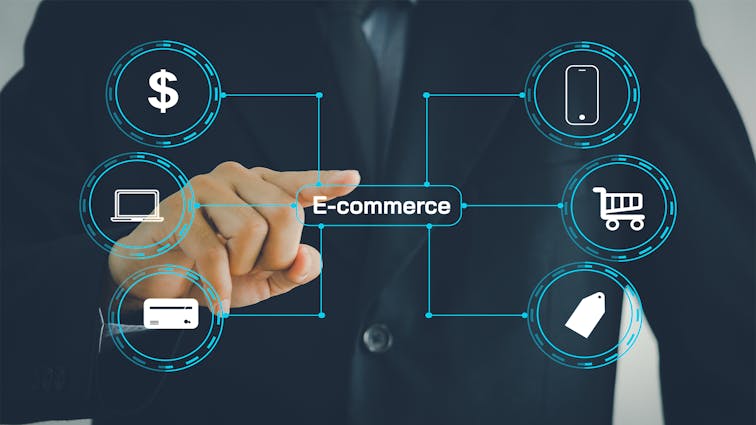
1. Increased Adoption by Small to Medium-Sized Businesses (SMBs)
While headless commerce platforms were initially adopted by larger enterprises with the resources to implement and maintain them, we are starting to see a shift towards increased adoption by small to medium-sized businesses (SMBs).
This is due in part to the benefits that headless commerce provides, such as flexibility, scalability, and customization. These benefits can be just as valuable for SMBs looking to grow their online presence as they are for larger enterprises.
One factor driving this trend is the increasing availability of affordable cloud-based solutions that make it easier for SMBs to implement and manage headless commerce platforms without having to invest in expensive infrastructure or technical expertise.
Another factor is the growing importance of e-commerce in today’s business landscape, where customers expect seamless online experiences regardless of the size of the company they are buying from.
2. More Focus on Mobile-First Experiences
With mobile devices accounting for an ever-increasing share of online traffic, more businesses are focusing on creating mobile-first experiences that deliver seamless shopping experiences across all devices.
This trend is particularly relevant for headless commerce platforms, which provide greater flexibility and control over how content is delivered across different channels.
One way this trend is playing out is through the use of progressive web apps (PWAs), which offer app-like functionality without requiring users to download a native app.
PWAs can be customized and optimized for different devices and offer features like push notifications and offline access that enhance the user experience.
Another way businesses are focusing on mobile-first experiences is through responsive design techniques that ensure their websites look great on any screen size.
In addition to improving user experience, focusing on mobile-first experiences can also have a positive impact on search engine optimization (SEO), since Google has indicated that it favors mobile-friendly websites in its search results.
This means that businesses that prioritize mobile-first experiences are not just catering to their customers’ preferences, but also improving their chances of being found online.
A Final Word
In the ever-evolving world of e-commerce, it’s essential to stay ahead of the curve and adopt technologies that enable your business to meet the needs and expectations of customers.
Headless commerce platforms can offer that flexibility, scalability, and customization that many businesses seek, particularly as mobile-first experiences become more critical.
However, the decision to adopt a headless commerce platform should not be taken lightly. Make sure to weigh the pros and cons, thoroughly research each platform, and carefully consider your specific business needs and goals before jumping in.
By following the guidelines outlined in this article, you’ll be well-equipped to make an informed decision on whether a headless commerce platform is the right choice for your business in Australia.
And if you decide to go with it, you can significantly enhance your online presence, deliver exceptional customer experiences, and stay competitive in today’s fast-paced digital landscape.
So, take the time to evaluate your options, weigh the benefits and challenges, and make a strategic decision that will best serve your business’s needs now and in the future. The success of your e-commerce endeavors depends on it.
Happy exploring, and here’s to your business’s continued growth in the exciting world of e-commerce!








